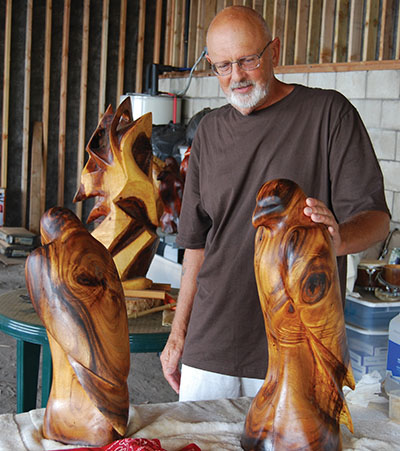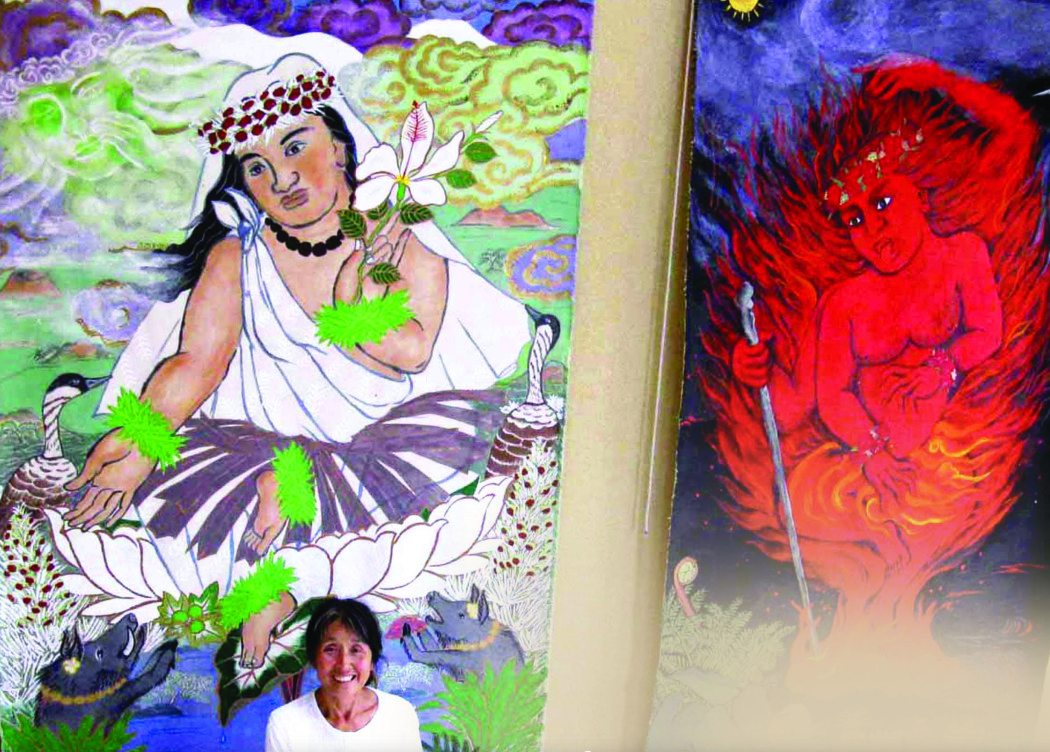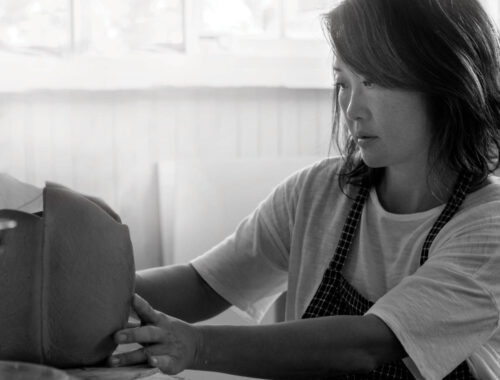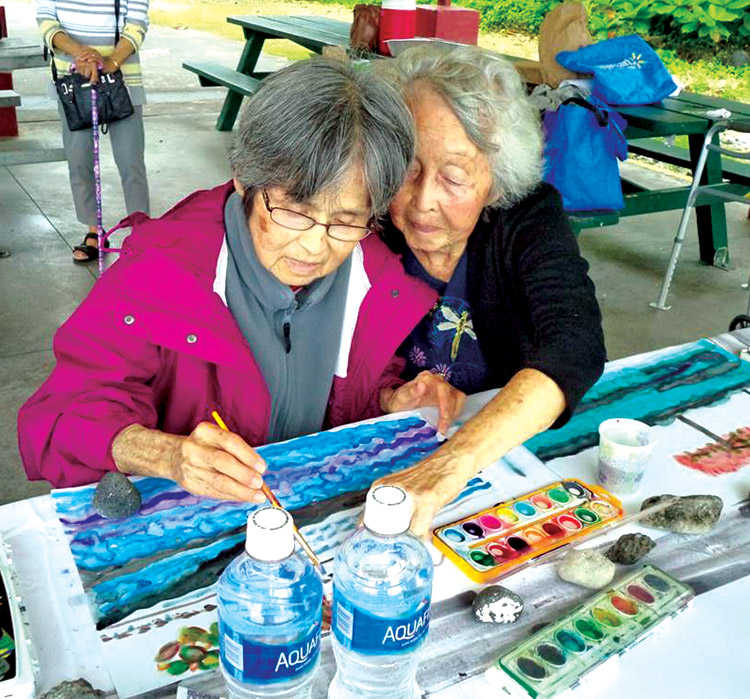
Making Life Colorfully Social for our Kūpuna
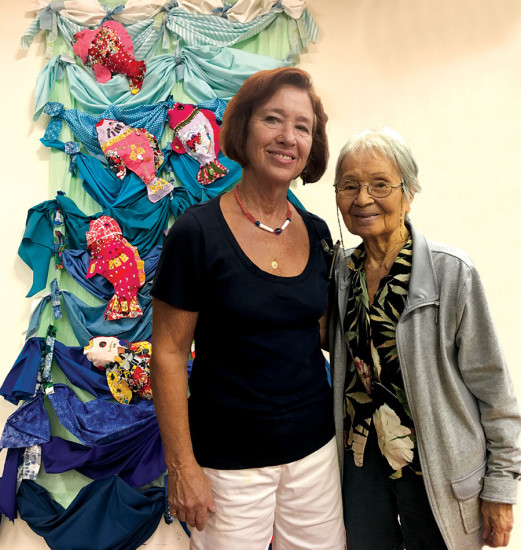
By Paula Thomas
Since 1976, the Hawai‘i Island Adult Care (HIAC) in Hilo has provided quality care for elders and challenged adults as well as support for their families. Their life-enhancing programs include an art program thatʻs been led by Lori Thal for the last 35 years.
Lori, an artist first, is able to conceive art projects such as whole, complex tapestries that eventually become the magnificently delightful creations hanging on the walls of HIAC.
The facility dazzles with color. Decorations hang from the ceiling and doorways and grace every arch. The kūpuna (elders) colorful art covers every expanse of wall. There is something to catch the eye everywhere you turn—one delightful surprise after another. The place feels positively joyful.
Lori takes great care to design the projects that make it onto the walls. The art is so well rendered that HIAC auctions them off periodically to raise funds. Some are cloth, others are loomed, and a few are whimsical wood sculptures. On an interior wall, hundreds and hundreds of puzzle pieces have been glued together to make a 3-D abstract “painting.” The projects require concentration, imagination, and sharing, all of which serve the health needs of the participants.
Art as Therapy

For Lori, creating art is a means to an end. The kūpuna create things, and practice eye-hand coordination, dexterity, spatial relations, and engage the imagination. “The work I do is less about the art, though,” Lori says with a sparkle in her eyes. “Really what we are doing is having a social experience.” And therein lies the deeper beauty of the artwork the kūpuna produce under Lori’s tutelage.
Over the span of her 35-year tenure, her art program has greatly evolved in terms of the range of projects, materials, and activities she makes available. A storage room shelved with supplies is adjacent to her kiln. In another storage room some clay trays line shelves, drying out so they can be glazed.
“Ceramics, watercolor, and other art projects are taught and offered to all of our participants,” notes Paula Uusitalo, the recently retired executive director. “Use of their eye-hand coordination coupled by their creativity are key factors to our participants’ thriving while at HIAC.”
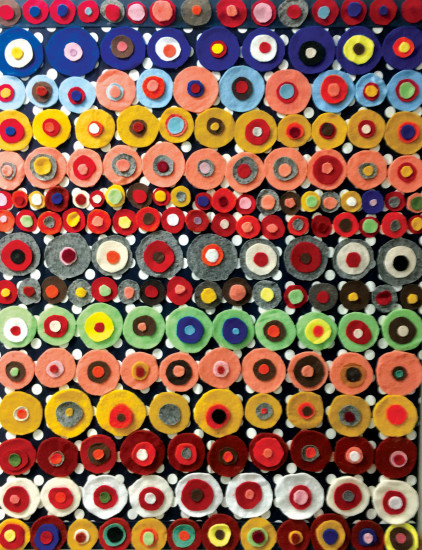
As an example, a fabric tapestry of winding anthuriums graces a wall. One can see that it is composed of individually created stems, finely orchestrated on a mat of green fabric, framed by yet more patterned fabric. To create this, the kūpuna sat around large tables with hundreds of bits of fabric (plus the all-important craft glue) and were set with the task of making an anthurium stem shadowed by a piece of maroon fabric. Once every stem was completed, the tapestry was laid out, glued, and the finished piece slipped onto a rod for hanging.
These group projects are a cornerstone of the art program: a large-scale concept broken down into elements, with each kupuna designing and producing one element that Lori then pieces together.
As the participants work on projects, they talk about their home life, children, people they know or have known, their experiences growing up. When projects are finished, the kūpuna do a show and tell: each person takes a turn showing her finished piece, sharing what thoughts and feelings came up during the process. The more intimate share time can be therapeutic and clues Lori and the staff in to what the kūpuna are experiencing day to day; what’s bringing them joy, sorrow, sadness, excitement. It is this sharing that makes the art projects so life-enhancing.
“Lori is also the master creator of the themed days (May Day, Halloween, Keiro No Hi, Christmas, Easter) . . . making large murals and coordinating activities and costumes for those events,” adds Paula. Themed days occur once a month, and October’s Halloween theme was Superheroes. Ever resourceful, Lori got her hands on a few superhero costumes, stuffed them, and tacked them to the holiday bulletin board. They perched protectively on the wall just behind the main seating area. When I visited, kūpuna were finishing up a painted “Halloween” banner, and glitter-trimmed cat masks (a craft project) sat ready for the end-of-month Halloween party.
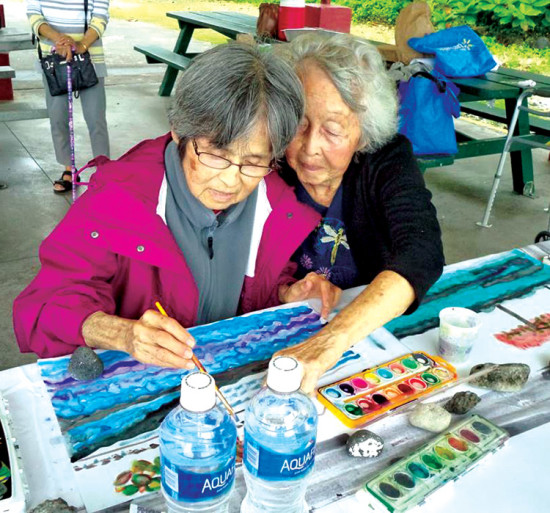
“Lori was the driving force to develop the activities calendar which is revamped every month to bring in variety and new ideas,” explains Paula, “and we are extremely lucky to have her [along with her] skills and understanding throughout the 35 years.”
Notably, Lori is the only art therapist on staff at HIAC and at any other adult day care center across the state. Everywhere else, Certified Nursing Assistants (CNAs) conduct most of the activities, including the art/craft projects. Her conceptions and the creative process she orchestrates make Lori a veritable treasure at HIAC.
These days, most of the kūpuna are in their 80’s and 90’s and live with their adult children. Most don’t drive and are brought to the old Hilo Hospital building by relatives or by an HIAC van that runs pick-up and drop-off service daily, Monday through Friday. “Not everyone comes every day,” Lori explains, “and some are in the Alzheimer’s wing, a completely separate area.”
Lori works there part of her day. “I am not a licensed psychologist,” she says, “but there are things you can determine from observing what the kūpuna create,” she says. “For example, I can detect cognitive decline from the way someone may draw something,” she explains, “and I can convey what I have observed to the family. It’s not medical advice or a diagnosis, but it’s information they ought to know.”
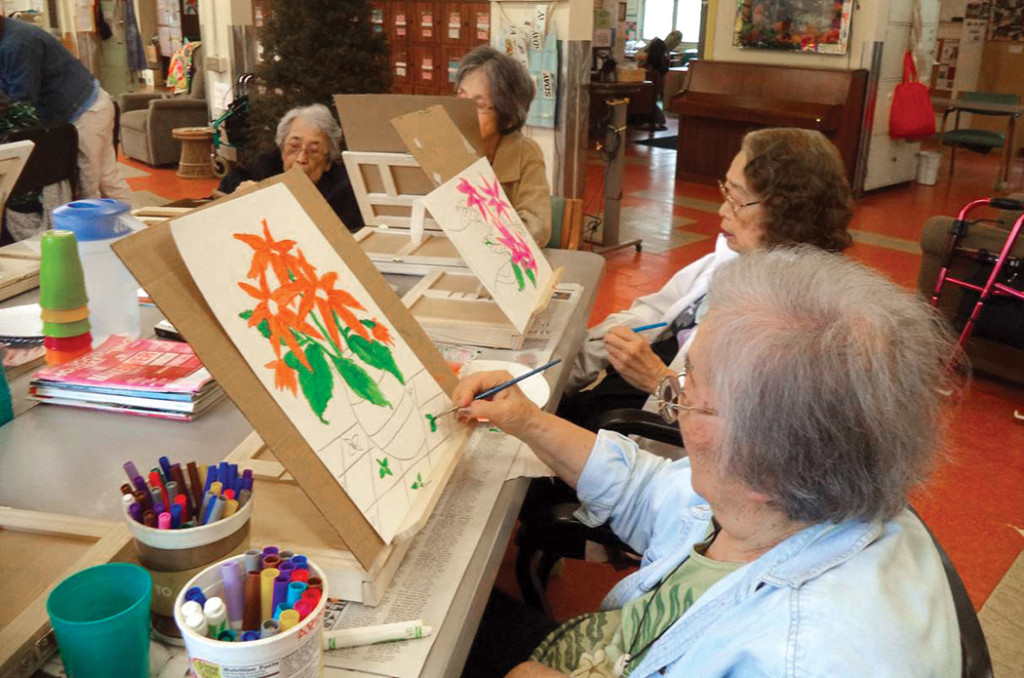
Serving Hilo for Over 40 Years
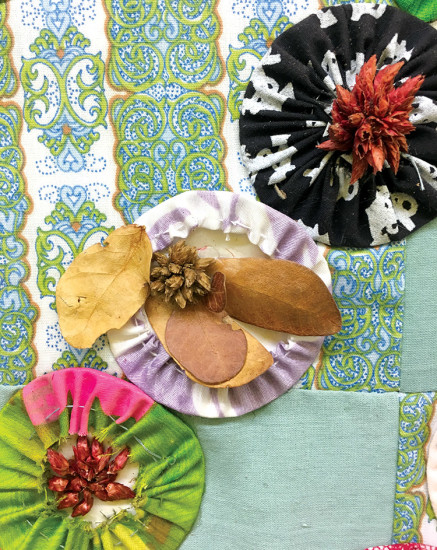
HIAC was founded in 1976 by Betty Nagao, who ran the program from the Kaumana Baptist Church. In 1981, the organization moved into the old Hilo Hospital building and Lori joined the staff not long after that. Betty now participates in the program she founded, and the two are at this point legendary.
Lori, who never dreamed she would be working with the elderly, has long been a vital creative force. “Some of our participants actually discover the ‘creative arts’ side of them while under the guidance of Lori,” notes incoming executive director Marcie Saquing. “To watch Lori work with our participants not only during her art activities, but during the course of the day, you can see her love and compassion for our participants. It’s magic.”
Lori arrived on Hawai‘i Island from Berkeley, hoping to become a high school art teacher. Initially she was a substitute teacher. Trained in art at Hunter College in New York and University of California, Berkeley, she knew she wanted to teach. However, the high schools in Hilo were not hiring full-time teachers, and she instead responded to an ad from Hawai‘i Island Adult Care. She was hired right away. Her Master’s in art therapy and gerontology came later as she continued her work with the kūpuna. She obtained the degree from Norwich College in Vermont when the field was just emerging.
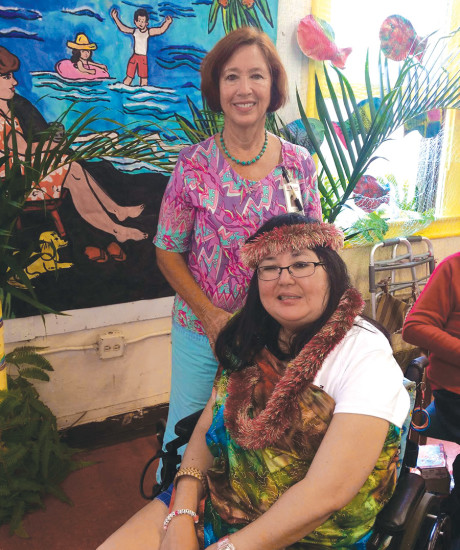
She loves her work and you can feel her passion, joy, and attentiveness. The monthly newsletter that goes out to families includes the calendar of events and a very special front page: a personal profile. Each month, Lori selects one personal story as the newsletter cover. Over the years, she has taken the time to sit and listen to each participant’s life story. She writes it up and adds a portrait that she has sketched to complete the profile.
Lori believes that personal recognition is important. “These men and women—they are all children from the plantation days,” she notes. “They are the last generation of people who have memory of plantation life and many of them came here from Asia with their parents. I have a stack of profiles,” she reflects, and gestures with her hand to indicate a four-inch thick pile. “For 35 years I have collected these,” she says. She makes six copies in all: Five go home with each kupuna for their families to review and share, and one she keeps.
The program at HIAC aims to support the elderly with day-to-day activities so they can stay vital and vibrant and age in place—that means stay with family or live at home for as long as possible. HIAC supports aging in place by offering full days of activity so kūpuna have a place to go during the day. It is closed only on Thanksgiving, Christmas, New Year’s Day, and the Fourth of July.
Future Home on the Horizon
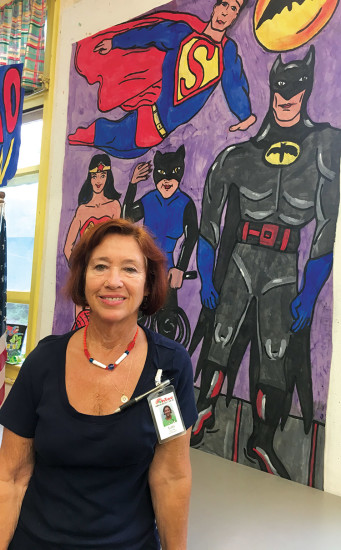
After more than 15 years in the planning, Hawai‘i Island Adult Care is moving to a brand new center designed by HIAC staff to specifically meet the programming needs, and will be located at the senior housing complex off of Mohouli Extension.
Marcie Saquing, excited about her new position says, “HIAC continues to strive and offer the best safe, quality daycare centers where our participants can thrive and remain in their own homes for as long as possible. I believe,” she continues, “that it takes our island community to raise up our kūpuna to continue their journey to thrive. The caregivers and loved ones of our participants are the real heroes. Together, we are truly making a positive difference in the lives of our kūpuna and other adults in need.
“We have a remarkable staff here. They love their jobs in caring for, nurturing and loving all of our participants who come to the centers. It takes a special kind of person to be a caregiver for others.”
Lori Thal is certainly special. She has dedicated her life and career to HIAC’s participants, conceiving ongoing activities and art projects to enhance and enrich the lives of Hawai‘i Island’s kūpuna—for her entire career. ❖
For more information, contact: hawaiiislandadultcare.org.
